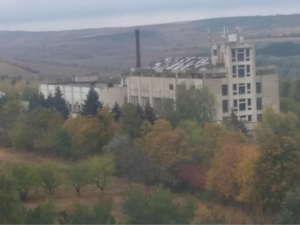
Defunct building at SAI which hosted two types of irradiators. Top floors were used for research laboratories.
Photo by Ionel Balan, NARNRA
Margarita Kalinina-Pohl
Michael Duitsman
November 2, 2016
In October 2016, CNS expert Margarita Kalinina-Pohl traveled to the Republic of Moldova for discussions with the National Agency for Regulation of Nuclear and Radiological Activities (NARNRA) on the implementation phase of the CNS-NARNRA collaborative project on tracking and locating orphaned and legacy radioactive sources in Moldova using new media tools. CNS launched this project in February and reported its initial findings in July.
In the earlier research phase of the project, NARNRA provided CNS with a list of 101 Soviet-era facilities known or suspected of working with or hosting radioactive sources. Using basic facility information, CNS researchers then collected former employees’ information from social media profiles, developed a database to organize this data, and used network analysis to identify the key individuals. The CNS team, composed of William Potter, Bryan Lee, Michael Duitsman, and Margarita Kalinina-Pohl, also developed an interview template—including guidelines, questions, and a set of visual aids featuring various radioactive sources—for NARNRA to use when interviewing subjects in the project’s implementation phase. At the October meeting, CNS and NARNRA experts revised and finalized the interview template. In addition to refining the template, NARNRA also added images of some sources which are likely to be found in Moldova.
The project implementation phase will include interviews by NARNRA representatives of those whose names were identified through network analysis and who have the highest degree of being “connected” to others through their shared experiences at the former Soviet enterprises where radioactive sources were used for research and commercial applications.
The CNS-NARNRA team tested this interview at the State Agrarian University (SAI) in Chisinau, which hosted a radiobiological laboratory that had conducted gamma irradiation experiments for agricultural research during the Soviet period. In the 2000s, all known radioactive sources at the laboratory were located and removed by NARNRA. Nonetheless, the interview provided a valuable opportunity and an exercise to test the CNS-developed interview and to demonstrate the value of social networks in locating orphaned and legacy sources. The interviewee, who served as an electrician engineer at the radiobiology laboratory, stated that his work did not involve the direct handling of sources. He did, however, identify other people who were directly involved in the laboratory’s research programs, and could have information about the radioactive sources used there. Several of these people have since been interviewed by NARNRA experts.
The next phase of the project will culminate with the report by CNS and NARNRA on preliminary findings at the December 2016 International Atomic Energy Agency conference Nuclear Security: Commitments and Actions in Vienna.
If successful, this model can be used by other states for tracking and locating radioactive sources and other materials which can pose threats to nuclear, chemical, and biological security.
This project is funded by a grant from the Skoll Global Threats Fund with support from the Swedish Radiation Safety Authority.
